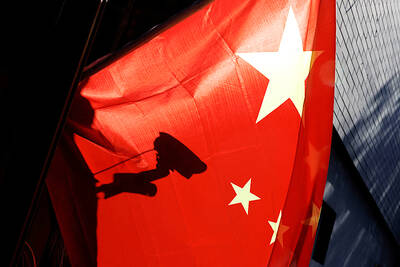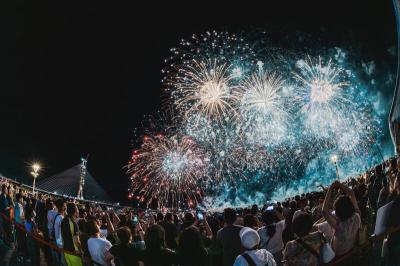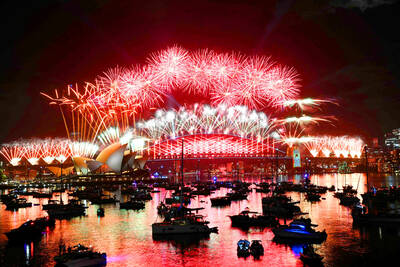Global spending on weapons now totals more than US$1.7 trillion, and Russia has overtaken Britain and France to take third place in the world league table, according to research figures released yesterday.
While military expenditure fell last year in most Western countries, including the US, which is facing serious budget deficits, Russia and China have continued to increase their spending on weapons — by more than 9 percent and 6 percent respectively last year, according to the Stockholm International Peace Research Institute (SIPRI).
The US remains by far the biggest military spender, with a defense budget of US$711 billion last year, followed by China, which spent an estimated US$143 billion on its armed forces last year. China has increased its military spending by 170 percent in real terms since 2002, the leading research body says.
Russia spent nearly US$72 billion on arms last year, overtaking Britain (US$62.7 billion) and France (US$62.5 billion) according to the institute. It says Russia is planning further increases, with draft budgets showing a 53 percent rise in real terms up to 2014.
Russia’s growing expenditure was mainly driven by the country’s aim to replace 70 percent of its Soviet-era military equipment with modern weaponry by 2020, SIPRI said, adding that it expects the Kremlin to increase its military spending in coming years.
”They are clearly putting very high priority on building up their military power again,” said Sam Perlo-Freeman, head of SIPRI’s Military Expenditure Project.
He said Russia lacks important modern communications technology for the battlefield and wants to hedge against the US’ overwhelming military might even if there is no current hostility between Russia and NATO.
However, SIPRI adds that many analysts are doubtful whether the industry will be able to carry out such ambitious plans after decades of stagnation after the collapse of the Soviet Union.
China’s increased military spending has caused concern among its neighbors and the US. The recent announcement of a US “pivot” toward Asia is in part the response to such concerns, SIPRI says.
“China’s extensive and growing trade relations with the countries in its neighborhood have been marred by disputes — eg the border dispute with India, a dispute over the Senkaku [Diaoyutai (釣魚台)] Islands with Japan, and contested maritime borders with several nations in the South China Sea — all of which have led to increased tensions,” it says.
Chinese military technology still lags behind the US’, SIPRI said.
“The US is still going to maintain for the foreseeable future overwhelming military dominance,” Perlo-Freeman said. “The US still outspends China five to one, and Russia’s spending is half of China’s.”
However, the report says talk of an arms race in the region may be premature, as both data and analysis reveal a mixed pattern of trends in military expenditure and arms acquisition, with China far from being the only driving factor.
Additional reporting by AP

A magnitude 7.0 earthquake struck off Yilan at 11:05pm yesterday, the Central Weather Administration (CWA) said. The epicenter was located at sea, about 32.3km east of Yilan County Hall, at a depth of 72.8km, CWA data showed There were no immediate reports of damage. The intensity of the quake, which gauges the actual effect of a seismic event, measured 4 in Yilan County area on Taiwan’s seven-tier intensity scale, the data showed. It measured 4 in other parts of eastern, northern and central Taiwan as well as Tainan, and 3 in Kaohsiung and Pingtung County, and 2 in Lienchiang and Penghu counties and 1

FOREIGN INTERFERENCE: Beijing would likely intensify public opinion warfare in next year’s local elections to prevent Lai from getting re-elected, the ‘Yomiuri Shimbun’ said Internal documents from a Chinese artificial intelligence (AI) company indicated that China has been using the technology to intervene in foreign elections, including propaganda targeting Taiwan’s local elections next year and presidential elections in 2028, a Japanese newspaper reported yesterday. The Institute of National Security of Vanderbilt University obtained nearly 400 pages of documents from GoLaxy, a company with ties to the Chinese government, and found evidence that it had apparently deployed sophisticated, AI-driven propaganda campaigns in Hong Kong and Taiwan to shape public opinion, the Yomiuri Shimbun reported. GoLaxy provides insights, situation analysis and public opinion-shaping technology by conducting network surveillance

Taiwan is gearing up to celebrate the New Year at events across the country, headlined by the annual countdown and Taipei 101 fireworks display at midnight. Many of the events are to be livesteamed online. See below for lineups and links: Taipei Taipei’s New Year’s Party 2026 is to begin at 7pm and run until 1am, with the theme “Sailing to the Future.” South Korean girl group KARA is headlining the concert at Taipei City Hall Plaza, with additional performances by Amber An (安心亞), Nick Chou (周湯豪), hip-hop trio Nine One One (玖壹壹), Bii (畢書盡), girl group Genblue (幻藍小熊) and more. The festivities are to

Auckland rang in 2026 with a downtown fireworks display launched from New Zealand’s tallest structure, Sky Tower, making it the first major city to greet the new year at a celebration dampened by rain, while crowds in Taipei braved the elements to watch Taipei 101’s display. South Pacific countries are the first to bid farewell to 2025. Clocks struck midnight in Auckland, with a population of 1.7 million, 18 hours before the famous ball was to drop in New York’s Times Square. The five-minute display involved 3,500 fireworks launched from the 240m Sky Tower. Smaller community events were canceled across New Zealand’s